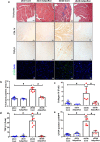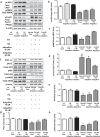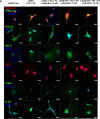Adiponectin receptor agonist ameliorates cardiac lipotoxicity via enhancing ceramide metabolism in type 2 diabetic mice
- PMID: 35351872
- PMCID: PMC8964809
- DOI: 10.1038/s41419-022-04726-8
Adiponectin receptor agonist ameliorates cardiac lipotoxicity via enhancing ceramide metabolism in type 2 diabetic mice
Abstract
Accumulation of lipids and their metabolites induces lipotoxicity in diabetic cardiomyopathy. Lowering ceramide concentration could reduce the impact of metabolic damage to target organs. Adiponectin improves lipotoxicity through its receptors (AdiopRs), which have sequence homology with ceramidase enzymes. Therefore, cardioprotective role of AdipoR agonism by AdipoRon was investigated. Sixteen-week-old male db/m and db/db mice were fed a diet containing AdipoRon for four weeks. Phenotypic and metabolic profiles with associated cellular signaling pathways involved in lipid metabolism were investigated in the mice heart and human cardiomyocytes to establish treatment effect of AdipoRon. AdipoRon ameliorated insulin resistance, fibrosis, M1-dominant inflammation, and apoptosis in association with reduced accumulations of free fatty acid, triglycerides, and TLR4-related ceramide in the heart. This resulted in overall reduction in the level of oxidative stress which ameliorated cardiac hypertrophy and its function. AdipoRon increased the expression of AdipoR1 and AdipoR2 via pAMPK/FoxO1-induced Akt phosphorylation resulting from a decrease in PP2A level. It also increased acid ceramidase activity which reduced ceramide and increased sphingosine-1 phosphate levels in the heart of db/db mice and cultured human cardiomyocytes. Consistent upregulation of AdipoRs and their downstream regulatory pathways involving pAMPK/PPARα/PGC-1α levels led to lipid metabolism enhancement, thereby improving lipotoxicity-induced peroxisome biogenesis and oxidative stress. AdipoRon might control oxidative stress, inflammation, and apoptosis in the heart through increased AdipoR expression, acid ceramidase activity, and activation of AMPK-PPARα/PGC-1α and related downstream pathways, collectively improving cardiac lipid metabolism, hypertrophy, and functional parameters.
© 2022. The Author(s).
Conflict of interest statement
The authors declare no competing interests.
Figures















References
Publication types
MeSH terms
Substances
LinkOut - more resources
Full Text Sources
Medical
Research Materials
Miscellaneous

